Understanding Cremation Furnace Costs: What You Need to Know
How much does a cremation furnace cost? The price depends on size, type, and features:
| Type of Unit | Cost Range |
|---|---|
| Human Cremation Furnace (New) | $135,000-$170,000 |
| Complete Human Crematory (Installation & Equipment) | $300,000-$500,000 |
| Pet Cremation Furnace (Small) | $4,000-$5,000 |
| Pet Cremation Furnace (Large) | Up to $100,000 |
| Aquamation Equipment | $209,900-$329,900 |
The death care industry represents a $17 billion market in the United States, with cremation steadily growing in popularity. For funeral home directors and veterinary clinic owners considering adding cremation services, understanding the true cost of a cremation furnace is essential for making sound business decisions. How much does a cremation furnace cost is one of the most common questions we hear, but the answer involves more than just the purchase price of the equipment.
When budgeting for a cremation furnace, you'll need to consider not only the initial equipment purchase but also installation, permitting, facility requirements, and ongoing operational expenses. The total investment varies significantly based on whether you're providing human or pet cremation services, your expected volume, and the level of automation desired.
I'm Mortuary Cooler, a national-level supplier of mortuary coolers and cremation equipment with extensive experience helping funeral homes steer how much does a cremation furnace cost questions and make informed purchasing decisions. Throughout my career working with funeral directors across the country, I've guided hundreds of businesses through the complex process of selecting and installing the right cremation equipment for their specific needs.
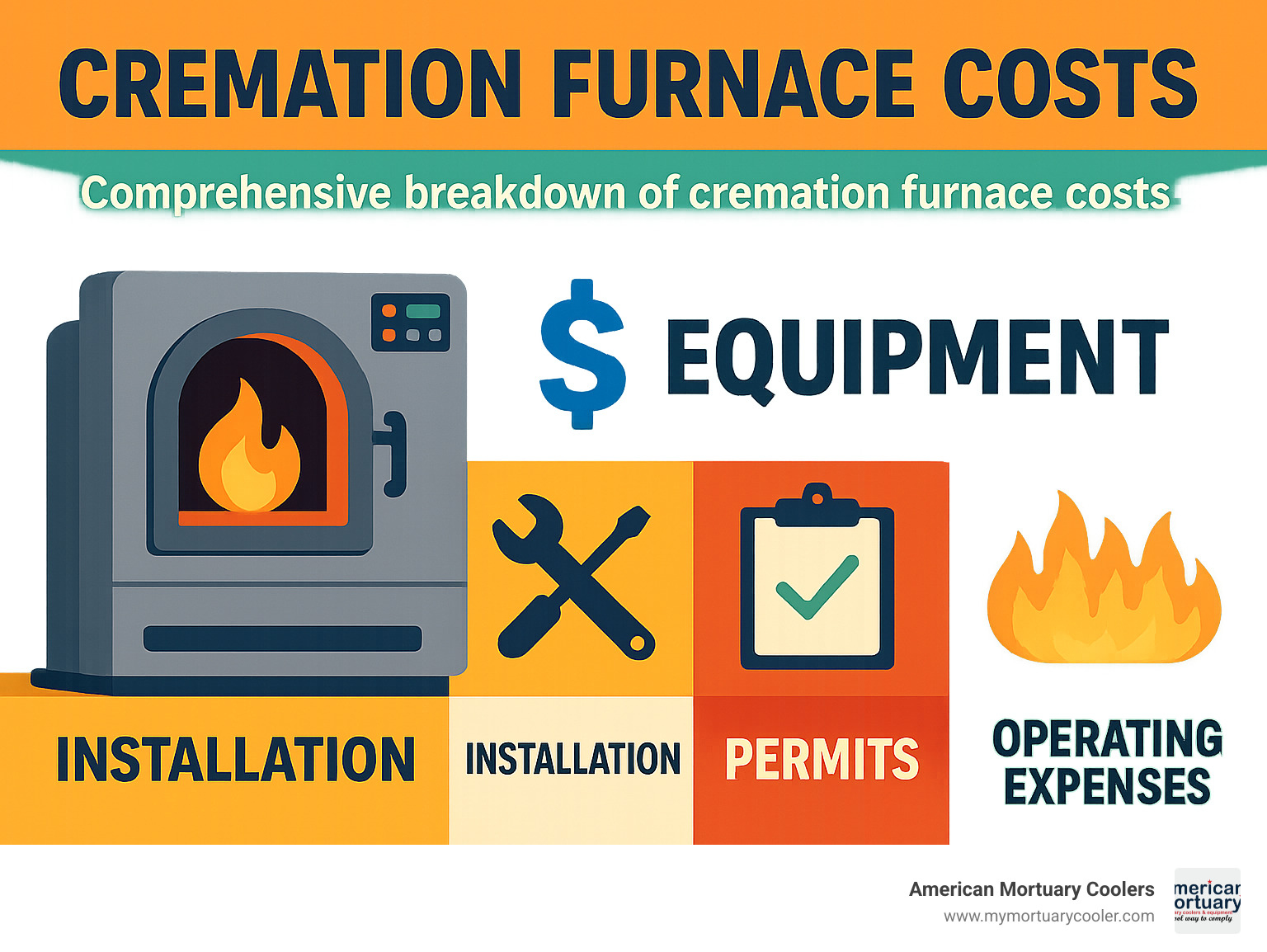
How much does a cremation furnace cost basics:
Cremation Furnaces 101: Types, Terminology & Capacities
Let's talk shop about cremation equipment before we dive into dollars and cents. If you're new to this world, you might hear terms like "incinerator," "retort," "chamber," and "furnace" tossed around interchangeably – but there are some important differences worth understanding.
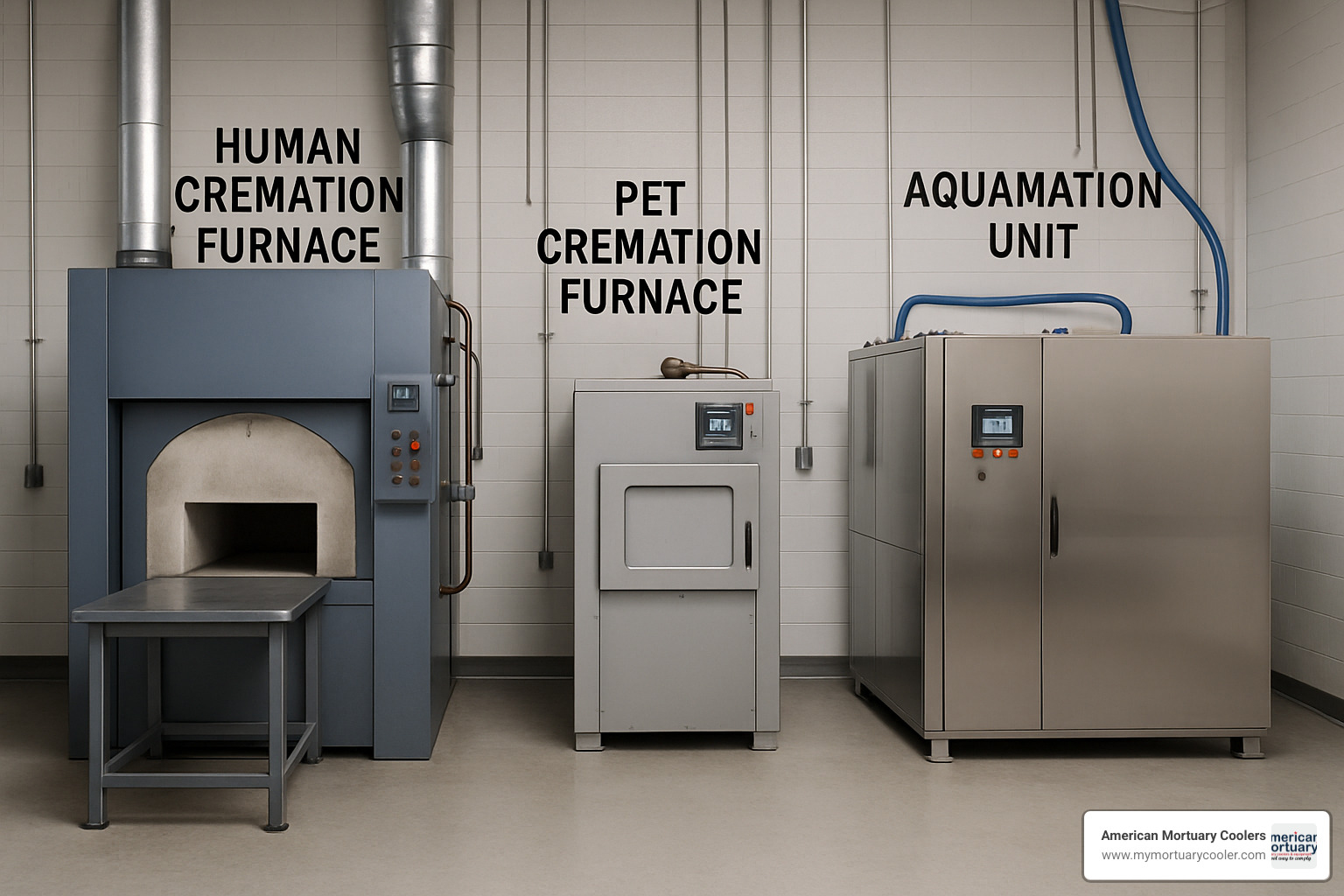
When we talk with funeral directors at American Mortuary Coolers, we find they're often comparing apples to oranges without realizing it. Cremation equipment varies significantly in capacity (measured in pounds), the fuel that powers it (natural gas, propane, or diesel), how automated the process is, environmental controls, and how quickly it can complete a cremation.
From our Tennessee headquarters, we've helped clients across all regions select equipment that makes sense for their specific situation – whether they're operating in the chilly Northeast or the sunny Pacific regions.
Incinerators vs. Chambers
Incinerators represent the entry-level option in cremation equipment. These more basic units start around $2,000-$5,000 for small urn-based models, while larger urn-based systems typically run $5,000-$10,000.
These units are perfect for pet cremation services or facilities that only handle cremated remains. The upside? They offer shorter cycle times. The downside? They have limited capacity and fewer features.
Cremation chambers (or retorts, as they're often called) are the workhorses of human cremation. Small chambers generally cost between $10,000-$15,000, while larger models range from $15,000-$20,000.
These chambers are specifically designed for whole-body cremation, featuring a primary chamber where the deceased is placed. A standard cremation cycle takes about 1-3 hours, depending on the chamber's size and efficiency. When someone asks, "how much does a cremation furnace cost," they're often thinking of these standard chambers.
What Makes a "Furnace" Different?
When we use the term "cremation furnace," we're typically referring to more sophisticated equipment with several important features:
First, a proper furnace includes a secondary burn chamber. This isn't just a fancy add-on – it ensures more complete combustion of gases and particulates, which means cleaner emissions and better efficiency. This feature adds about $10,000-$20,000 to your investment but is often required to meet environmental regulations.
Second, quality furnaces use specialized refractory lining that can withstand extreme temperatures up to 1,800°F (982°C). Think of this like the difference between cooking with a dollar store pan versus professional-grade cookware – the quality of this lining directly impacts how long your furnace will last and how often you'll need maintenance.
Third, modern furnaces incorporate PLC controls (Programmable Logic Controller systems) that automate the cremation process. These smart systems maintain optimal temperatures and airflow throughout the cycle, improving efficiency and reducing operator error. They add $5,000-$15,000 to the cost but pay for themselves through improved performance.
With these advanced features, cremation furnaces typically cost $20,000-$30,000 for smaller models and $30,000-$40,000 for larger units. As you can see, when asking "how much does a cremation furnace cost," the answer depends heavily on these specifications.
Scaling Up to Full Cremation Systems
For high-volume facilities, a full cremation system offers the most comprehensive solution. These systems feature:
Multi-chamber designs allow for continuous operation, meaning you can process multiple cremations throughout the day without downtime. Integrated loading and processing equipment streamlines your workflow, while quick-change hearth systems minimize maintenance downtime. Many also include remote diagnostics capabilities so technicians can troubleshoot issues without an on-site visit.
These advanced systems range from $50,000 for smaller units to $200,000 for large, high-capacity systems. Yes, that's a substantial investment upfront, but these systems maximize throughput and efficiency for busy facilities.
One innovation worth mentioning is the Quick Change Hearth System, which allows you to replace hearth tiles in a single day without a lengthy dry-out cycle. This might sound like a small detail, but when your equipment needs maintenance, this feature can save you days of downtime.
Want to learn more about the equipment that makes a crematory function? Check out our detailed guide on tools of the trade for cremation professionals.
How Much Does a Cremation Furnace Cost?
Now that we understand the different types of equipment, let's talk about what you're really here to learn - the actual costs. When funeral directors ask me "how much does a cremation furnace cost," I always tell them it's not just about the sticker price on the machine.
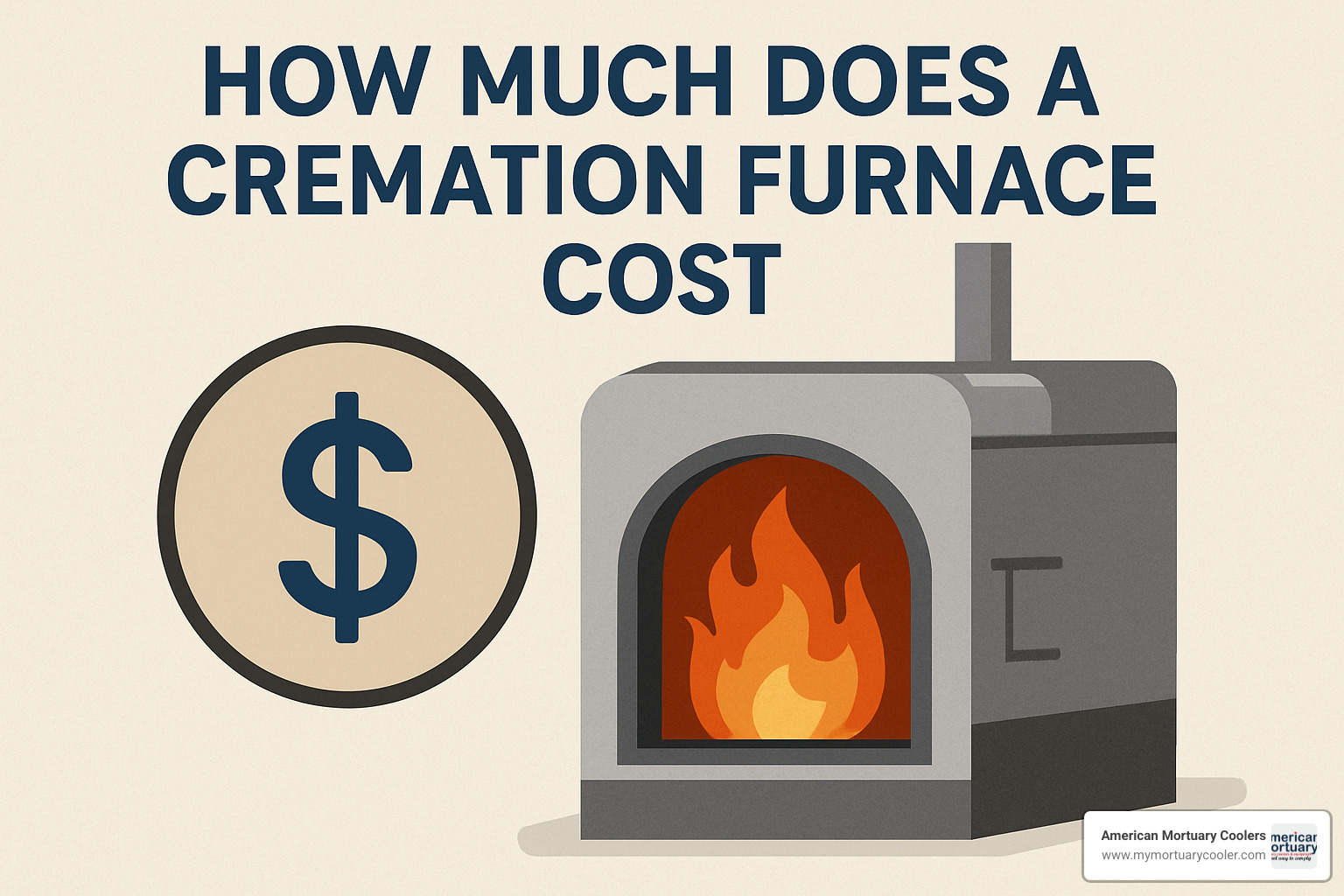
The price varies widely based on whether you're buying new or used equipment, if you need human or pet cremation capacity, which brand you choose, how automated you want the system to be, what environmental controls are required in your area, and the specific installation requirements of your facility.
In my conversations with funeral home owners across the country, I consistently hear that the all-in cost for a crematory typically falls between $300,000 and $500,000 for a complete human cremation facility. This includes everything from the machine itself to delivery, setup, contractor work, permits, and all those little expenses that tend to add up.
Human Units: how much does a cremation furnace cost in 2024?
If you're looking at human cremation furnaces (retorts) in today's market, here's what you can expect to pay in 2024:
For the retort itself, you're looking at $135,000-$170,000 as your base equipment cost. But that's just the beginning. You'll also need to factor in installation and setup costs of $30,000-$50,000. If your building needs modifications (and most do), that's another $120,000 or more for a typical 1,200 sq ft prefabricated metal building. Don't forget permits and regulatory approvals, which can run you $5,000-$15,000 depending on your location.
Most human cremation furnaces come with a standard two-year parts warranty, though you can usually purchase extended coverage. With proper maintenance, you can expect your cremation furnace to serve you for 15-20 years, and many of our clients report their units lasting even longer with regular care and occasional refurbishment.
The major players in the U.S. manufacturing market include Matthews Environmental Solutions, B&L Cremation Systems, Cremation Systems, FT USA, and American Crematory Equipment Co. Each has their strengths, and we're happy to walk you through the differences when you're ready to make a choice.
Pet & Small-Animal Units: how much does a cremation furnace cost for clinics?
The pet cremation market has been booming lately, and we're seeing many veterinary clinics adding this valuable service. The cost structure is quite different from human cremation equipment:
Entry-level units for small pets start around $4,000-$5,000 for basic single-chamber models. Mid-range units suitable for standard veterinary clinic use typically run $20,000-$30,000. If you're planning a high-volume pet cremation business, larger multi-chamber units can cost up to $100,000.
The numbers make sense for many clinics. A standard small pet crematory unit costs about $21,700, with total annual operating costs estimated at $21,648. With potential annual sales of $47,520 (assuming you do 264 cremations per year at $180 each), the return on investment can be quite attractive.
For example, a small clinic performing just one pet cremation per day can achieve a net annual profit of $20,332 after accounting for the five-year equipment payoff. No wonder so many vets are adding this service! For more details on the ROI for pet cremation, check out our article on the real cost of cremation machines.
Budgeting for Used or Refurbished Equipment
If your budget is tight (and whose isn't these days?), used or refurbished cremation furnaces can offer significant savings:
Used human cremation furnaces typically sell for $50,000-$100,000, which is about 60-70% of the new price. Refurbished units that come with a warranty generally run $80,000-$120,000.
When shopping for used equipment, I always advise my clients to do their homework. Request those maintenance records and operational history. Take time to inspect the refractory lining for cracks or excessive wear. Make sure to test all control systems and burners. Verify the unit complies with current emissions standards in your area (this is crucial). And don't forget to factor in relocation and reinstallation costs, which can be substantial.
One thing to keep in mind: financing used equipment often comes with higher interest rates or shorter terms, which can impact your overall cost calculation. It's worth talking to your financial advisor about the best approach for your specific situation.
For a deeper dive into the features that drive cremation equipment costs, check out this scientific research on cost drivers.
Total Cost of Ownership: Running, Maintaining & Permitting
When you're asking "how much does a cremation furnace cost," remember that the purchase price is just the beginning of your investment journey. To truly understand what you're committing to financially, we need to look at the complete picture of ownership costs.
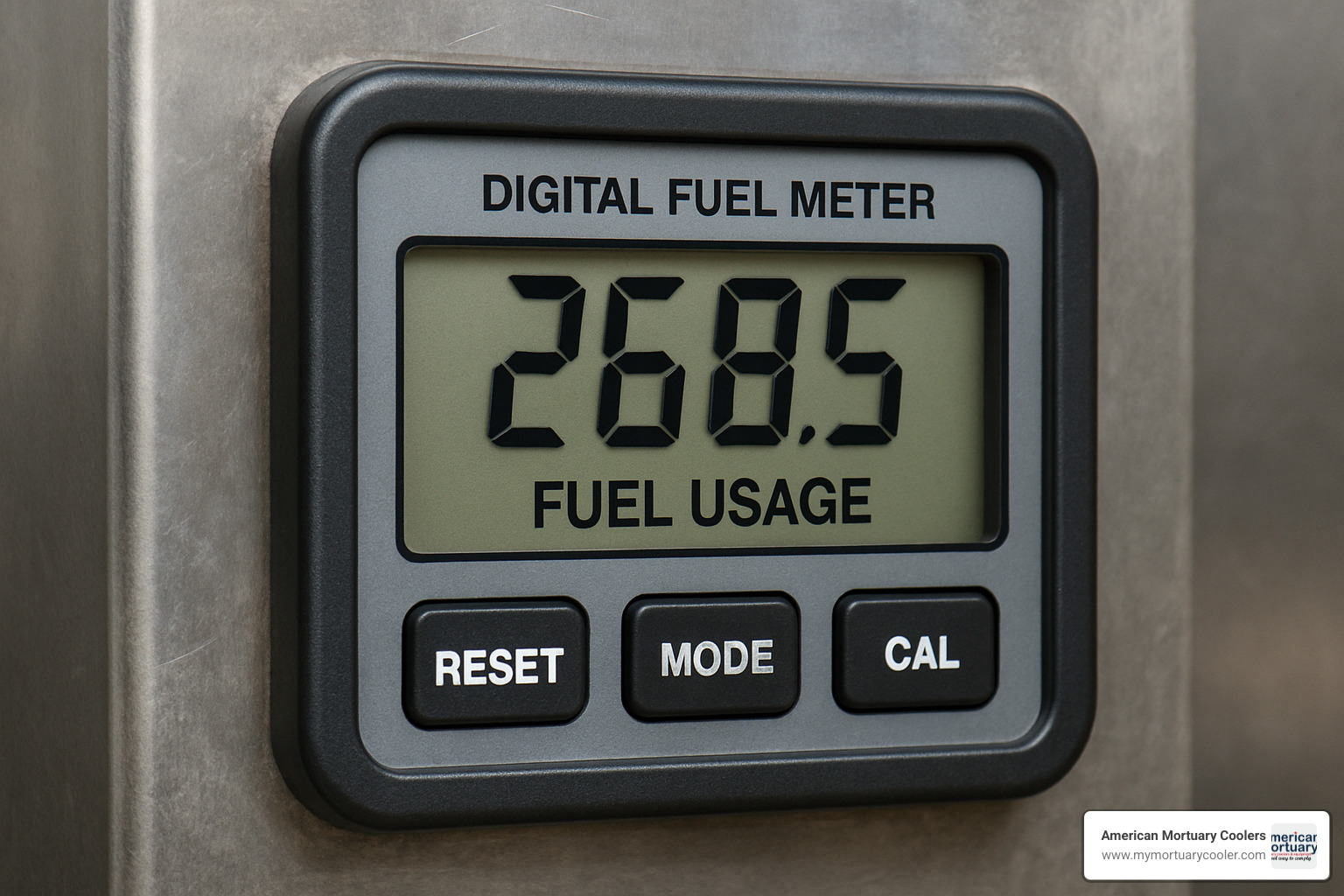
Up-Front Extras Most Buyers Forget
I've seen it time and again - funeral directors budget for the furnace itself but get blindsided by these essential extras. Shipping will set you back $5,000-$15,000 depending on how far you are from the manufacturer (we deliver across all 48 contiguous states, which helps control these costs).
Don't forget about the crane services ($2,000-$5,000) - these units aren't exactly light! The rigging team ($1,500-$3,000) ensures your furnace is positioned precisely where it needs to be. And those utility upgrades? They're often a surprise, costing anywhere from $5,000-$20,000 to bring your gas lines, electrical service, and ventilation up to code.
Then there are the accessories you'll absolutely need: a hydraulic lift table ($5,000-$7,000), remains processor ($2,500-$5,000), cooling rack ($400-$500), processing station ($9,000-$14,000), and a high-temperature vacuum system ($1,500-$2,000). These aren't luxury add-ons - they're essential tools of the trade that make daily operations possible.
Ongoing Operating Costs & Lifespan Math
Once you're up and running, the meter starts ticking on operational costs. Fuel consumption typically runs $20-$40 per cremation. If you're using natural gas, expect to use 12.5-28.5 therms per cremation; for LPG, it's about 10.5-18.5 gallons.
A little industry secret? Running at 40-60% capacity often provides the best fuel efficiency. Too many cremations back-to-back can overheat your system, while too few means constantly reheating cold chambers.
Annual maintenance isn't optional if you want your equipment to last - budget $2,000-$5,000 for standard service visits. Your refractory repair will come due every 5-7 years at $5,000-$15,000, and burner replacement every 8-10 years at $3,000-$6,000.
Your insurance company will notice your new equipment too - expect premium increases of $500-$1,000 annually. And don't forget labor costs of $15-$25 per hour for trained operators who know how to run the equipment safely and efficiently.
When we help our clients calculate their ROI, we typically divide the total equipment cost by its expected lifespan (15-20 years with proper maintenance) and add annual operating expenses to determine the true per-cremation cost. This approach provides a much clearer picture than just looking at the purchase price alone.
Regulatory & Environmental Fees
The regulatory landscape adds another layer of ongoing costs that vary dramatically depending on your location. Zoning approval fees run $1,000-$3,000 in application and hearing costs. Air quality permits range from $2,000 in rural areas to $10,000+ in strict urban environments.
Many jurisdictions now require opacity monitoring equipment ($5,000-$10,000) and regular emissions testing ($1,500-$3,000 annually). In areas with particularly stringent air quality standards, you might need scrubber systems that can exceed $200,000, plus ongoing chemical costs of $5,000-$10,000 annually.
We've helped clients from New York to California steer these regional differences. Urban facilities typically face much stricter requirements than those in rural locations, which can significantly impact your total operating costs. More info about hidden costs is available if you'd like to dive deeper into these expenses.
At American Mortuary Coolers, we believe in transparent pricing and helping you understand the full financial picture before you make this significant investment. After all, how much does a cremation furnace cost isn't just about the price tag on the equipment - it's about what it will cost to own and operate for the next two decades.
Alternatives, ROI & Financing Strategies
When you're considering adding cremation services to your business, traditional flame cremation isn't your only option. Let's explore the alternatives and how to make the numbers work for your specific situation.
| Method | Equipment Cost | Installation | Operating Cost/Cremation | Environmental Impact |
|---|---|---|---|---|
| Flame Cremation | $135K-$170K | $30K-$50K | $20-$40 | Moderate |
| Aquamation | $210K-$330K | $40K-$60K | $15-$25 | Low |
| Pet Cremation | $4K-$100K | $5K-$20K | $10-$30 | Low-Moderate |
Aquamation vs. Flame Cremation Costs
Aquamation (alkaline hydrolysis) has been gaining serious traction as the eco-friendly alternative to traditional cremation. If you're in an area where environmental concerns are top-of-mind for your clients, this might be worth the higher initial investment.
The numbers tell an interesting story:
- Equipment cost: $209,900 for a basic system, climbing to $329,900 for premium models
- Installation: $40,000-$60,000 (those specialized plumbing requirements add up!)
- Operating costs: A more modest $15-$25 per cremation
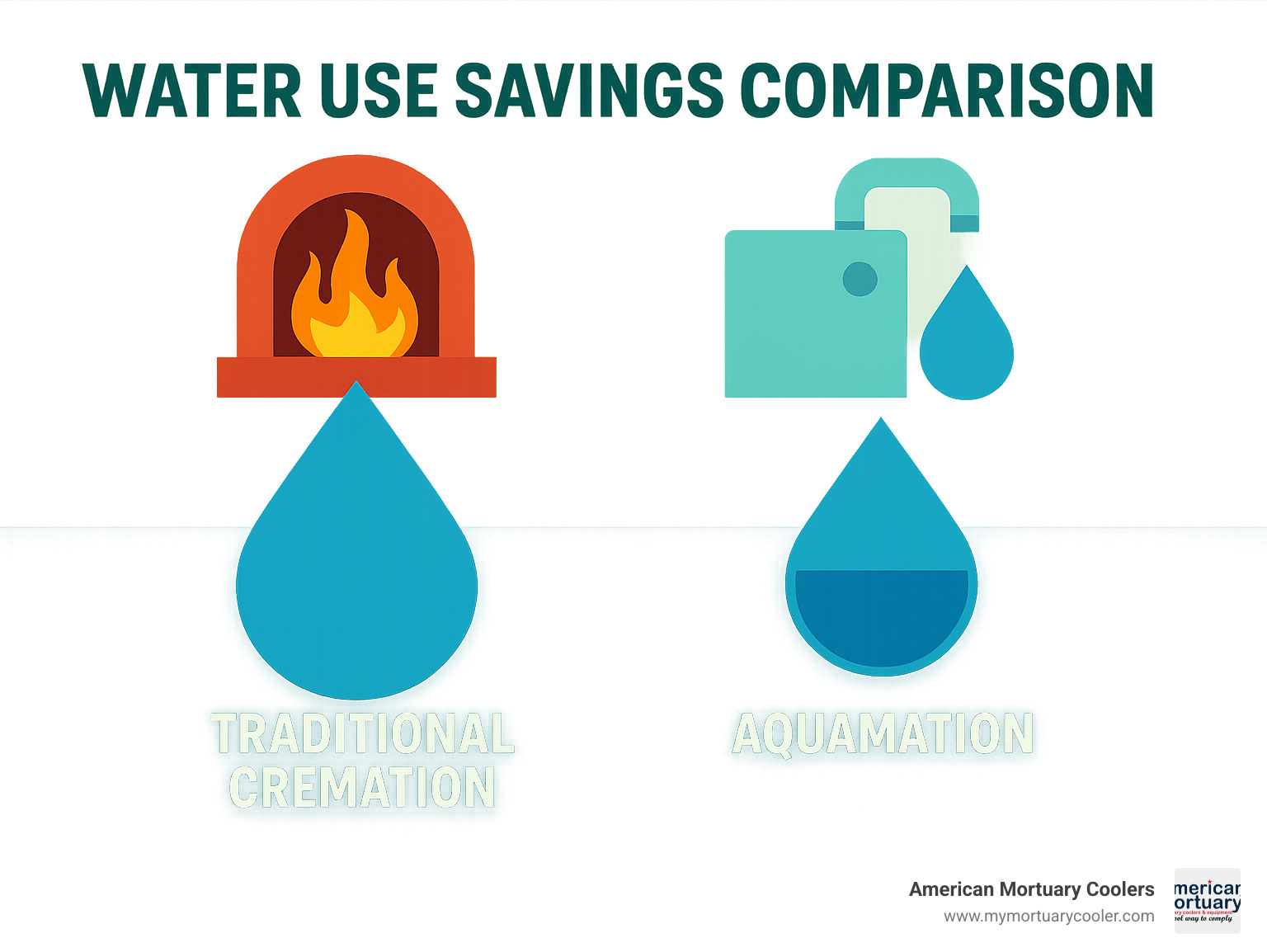
Modern aquamation systems have gotten smarter about water usage, with recycling capabilities that reduce both environmental impact and utility costs. While you'll pay more upfront than with flame cremation, many funeral homes have found they can charge premium rates for this "greener" option, which helps offset the higher initial cost.
Buy, Lease, or Finance?
I've worked with funeral directors across the country, and I've seen all three approaches work well depending on the business situation. Let's break down your options:
Cash purchase makes sense if you have the capital and want the lowest long-term costs. You'll own the equipment outright, benefit from depreciation on your taxes, and have complete control over your asset. The downside? That's a big chunk of cash to part with all at once.
Equipment leasing offers a middle path with minimal upfront costs and predictable monthly payments. Many leases include maintenance packages (a nice bonus!), and you'll typically have the option to purchase the equipment when the 3-7 year term ends. This can be a smart way to preserve capital for other business needs.
Operating leases provide the lowest monthly payments with no ownership responsibility at the end. They typically include service warranties and make it easier to upgrade as technology improves. If you prefer staying current with the latest equipment without the hassle of selling used equipment, this might be your best bet.
For a typical $150,000 cremation furnace on a 5-year term, here's what you might expect to pay monthly:
- Equipment loan (4% interest): ~$2,760/month
- Equipment lease: ~$3,000-$3,500/month
- Operating lease: ~$2,500-$3,000/month
SBA loans deserve special mention here – they're incredibly popular in our industry because they offer terms up to 10 years with competitive interest rates. This longer term significantly improves your cash flow during those critical early years when you're building your cremation service business.
At American Mortuary Coolers, we've helped funeral homes across all 48 contiguous states figure out which approach makes the most sense for their specific situation. How much does a cremation furnace cost ultimately depends not just on the equipment price, but on how you choose to finance it and what works best for your business model.
Step-by-Step Buying & Installation Checklist
Purchasing a cremation furnace isn't just about signing a check - it's a journey that requires careful planning and coordination. Having guided funeral homes across the country through this process, I've seen how proper preparation makes all the difference.
The path to operating your own cremation furnace typically follows these ten key steps:
- Site selection and evaluation
- Zoning approval and community hearings
- Vendor quotes and equipment selection
- Contract signing and deposit
- Building preparation or construction
- Equipment delivery
- Installation and setup
- Operator training
- Final inspection and certification
- First cremation and operational verification
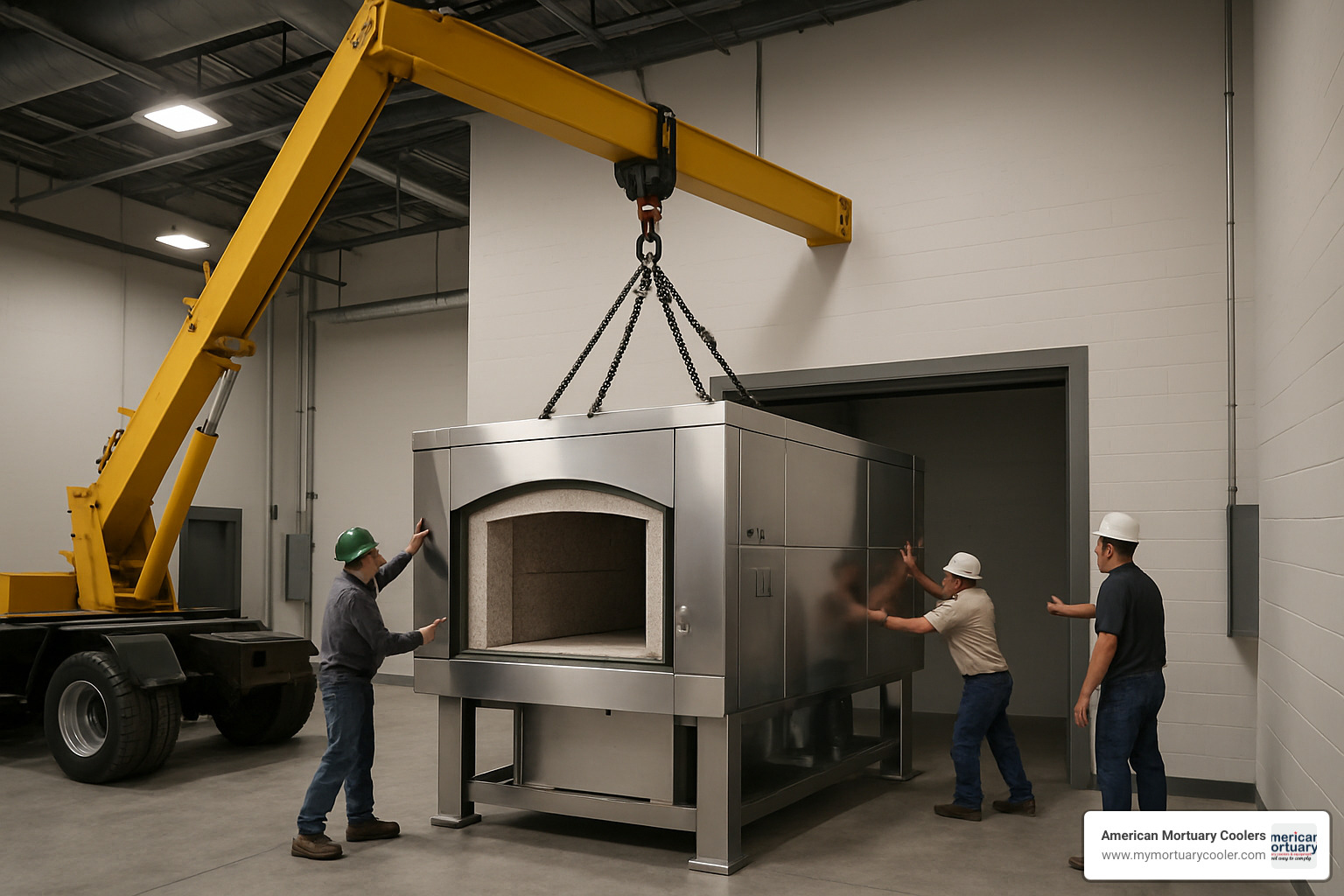
When installation day arrives, things move surprisingly quickly. Most of our clients are amazed at how efficiently the process unfolds. A typical installation timeline spans just three days: Day 1 brings equipment delivery and retort installation (that dramatic crane moment you see above!), Day 2 focuses on connecting utilities and initial system testing, and Day 3 involves operator training and your first cremation.
Permitting & Community Relations
Let's be honest - no one gets excited about the permitting process, but it's absolutely crucial. How much does a cremation furnace cost in terms of time and community goodwill can depend greatly on how you handle this stage.
Securing permits often requires meaningful community engagement. You'll need to prepare for public meetings where you'll address concerns about emissions, traffic, and property values. Having manufacturer specifications ready to demonstrate compliance with environmental standards is essential.
One question we hear constantly: "Will there be an odor?" This is where you can explain how modern furnace technology effectively eliminates detectable odors - a fact that often surprises and reassures community members.
Being proactive with neighbors pays dividends. Many of our clients from Chicago to Dallas have found that transparent, respectful communication with the community helps smooth the approval process. One funeral director in Minneapolis told me, "The extra hour I spent at that neighborhood meeting saved me months of delays."
Final Acceptance & Staff Certification
Before you can begin operations, there's a final but critical phase: ensuring your team is fully prepared to operate the equipment safely and efficiently.
This means making sure all operators receive proper certification, which typically involves 8-16 hours of training. You'll need to establish OSHA-compliant safety protocols that everyone understands and follows. Creating maintenance log systems isn't just good practice - it's often required for regulatory compliance.
At American Mortuary Coolers, we don't just drop off equipment and disappear. We provide comprehensive training for your staff and schedule follow-up support as needed. After all, how much does a cremation furnace cost in the long run depends greatly on proper operation and maintenance.
One funeral director in Ohio shared, "The training was worth its weight in gold. When we had an unusual situation six months later, we knew exactly what to do because of how thoroughly we'd been prepared."
This final phase isn't just about checking boxes - it's about giving your team the confidence and skills they need to provide this important service to your community with dignity and respect.
Frequently Asked Questions about Cremation Furnace Costs
What is the average payback period for a human cremation furnace?
One of the most common questions we hear at American Mortuary Coolers is about return on investment. For a typical mid-sized funeral home that performs around 100 cremations annually with a 60% cremation rate, you're looking at a payback period of 5-7 years.
Here's the simple math: When you compare outsourcing cremations to a trade provider (approximately $21,000 annually) versus bringing those services in-house (about $18,900 including financing and operational costs), you'll save roughly $2,100 per year. That might not sound like much, but as cremation rates climb to 70% or higher in your area—which is the national trend—that payback period shrinks dramatically.
Plus, there's the added benefit of maintaining control over the entire process and offering families the comfort of knowing their loved one never leaves your care.
Do electric cremation furnaces really lower operating costs?
I wish I could tell you that electric cremation furnaces are the budget-friendly option, but the truth is a bit more nuanced. While electric units do produce lower emissions and often make the permitting process smoother (a blessing in urban areas!), they typically cost more to operate than gas-fired units in most regions.
How much does a cremation furnace cost to run? The average electric cremation runs about $40-$60 in energy costs per cremation, compared to $20-$40 for natural gas. That difference adds up quickly when you're performing hundreds of cremations yearly.
That said, the landscape is changing. As renewable energy becomes more prevalent and electricity prices potentially stabilize or decrease, electric units might become the more economical choice in the future. For now, gas remains the cost leader in most markets.
How tall does my exhaust stack need to be to meet code?
Stack height is one of those details that can catch new crematory owners by surprise. Most cremation furnaces require a stack that extends at least 10 feet above the roofline of the nearest building. Standard installations typically include two 5-foot refractory stack sections (totaling 10 feet) per unit.
But—and this is important—local regulations can vary wildly. Your required stack height might be significantly taller based on:
- The height of surrounding buildings
- Local topography (especially in valley areas)
- Prevailing wind patterns
- Population density
I've seen requirements range from the standard 10 feet all the way to 25+ feet in certain urban areas. This is definitely an area where you'll want to check your local air quality regulations early in the planning process. The last thing you want is to install your furnace only to find you need an additional 15 feet of stack height!
At American Mortuary Coolers, we've helped clients steer these regulations across all 48 contiguous states, and we're always happy to share our experience with the requirements in your specific area.
Conclusion
When exploring the question "how much does a cremation furnace cost," we've finded that the answer extends well beyond the sticker price. A complete human cremation facility typically requires an investment between $300,000 and $500,000, while pet cremation options can start at a much more accessible $4,000-$5,000 for basic units.
Making the right choice for your business isn't just about finding the lowest price—it's about finding the right fit. Think of it like buying a home rather than a car: this equipment will be with you for decades, becoming an essential part of your business identity and service offering.
When weighing your options, consider these key factors:
- Your current volume and how you expect it to grow in the next 5-10 years
- The physical space you have available and any facility modifications needed
- Local regulations and environmental requirements in your specific area
- Your financial situation and preferred financing approach
- How cremation fits into your long-term business vision
Here at American Mortuary Coolers, we've walked alongside hundreds of funeral professionals as they've steerd this significant decision. From our home base in Tennessee, we've helped businesses in every corner of the country—from snowy Pittsburgh to sunny Los Angeles—find their perfect cremation equipment match.
We understand that for most funeral homes, this represents one of the largest capital investments you'll ever make. That's why we take the time to understand your unique situation before recommending equipment. We'll help you look beyond the initial purchase price to understand the total cost of ownership over the equipment's lifespan—including those often-overlooked expenses that can surprise unprepared buyers.
Ready to explore your options? Our team is here to provide a friendly, no-pressure consultation about cremation equipment that fits your needs and budget. Reach out to us today to start the conversation—we're here to help you make this important business decision with confidence and clarity.
For more information about cremation equipment options, check out our detailed guide on cremation equipment and tools of the trade.



















